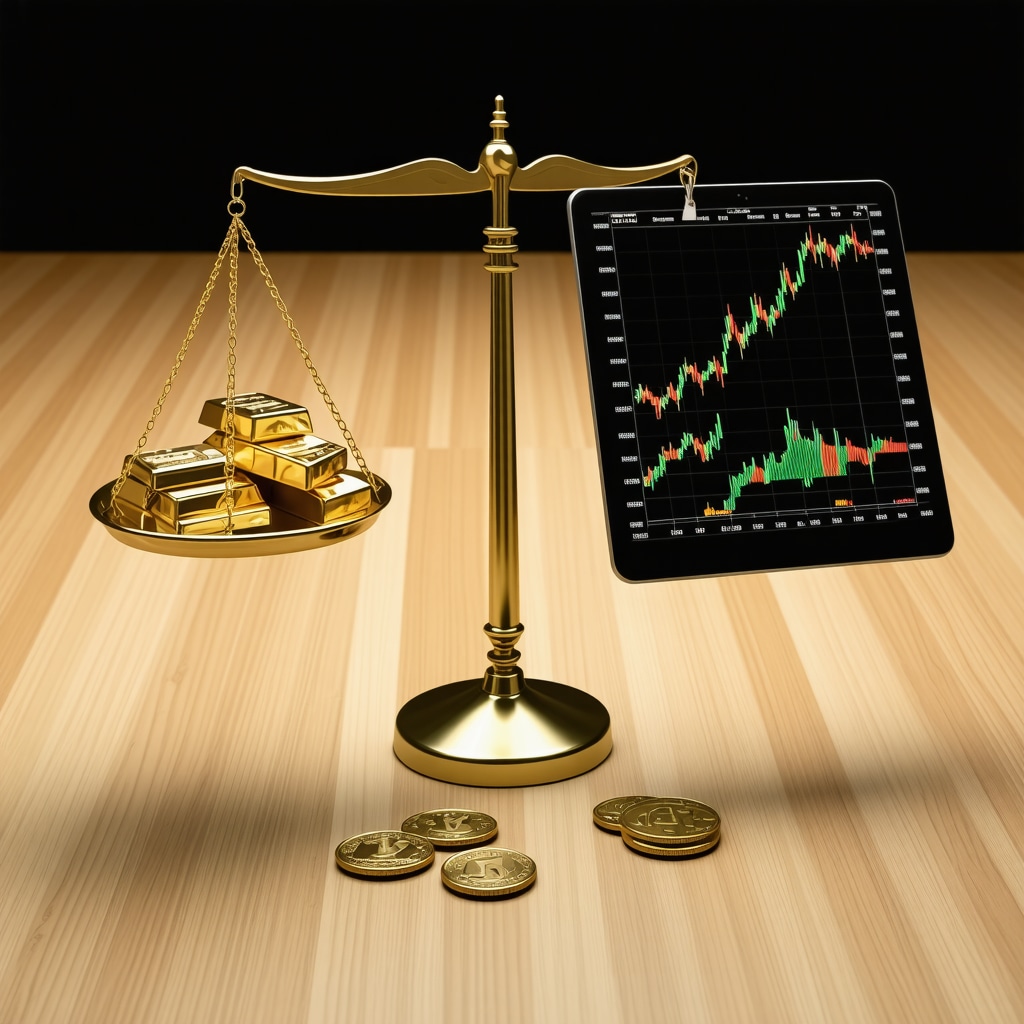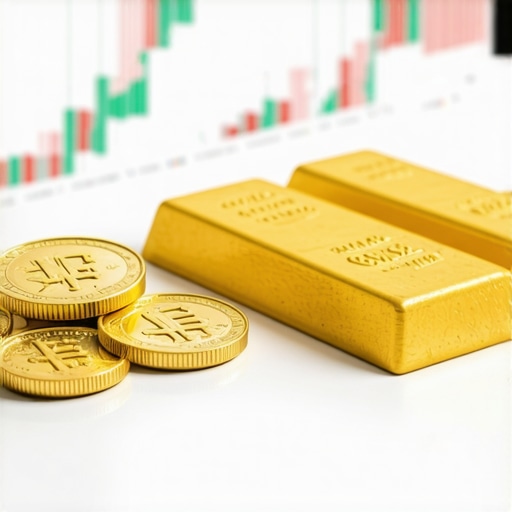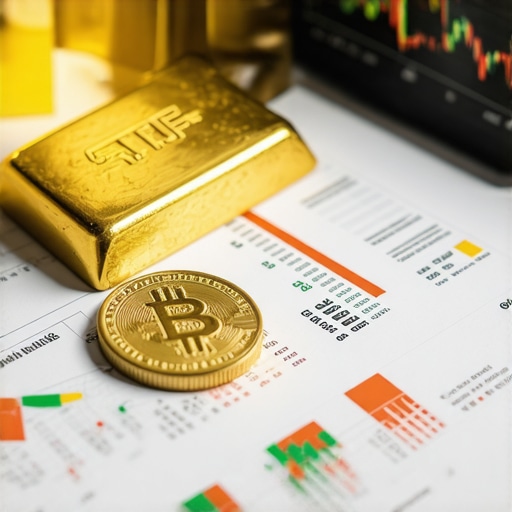Unveiling the Golden Dilemma: Tangible Treasure or Digital Asset?
Investors often find themselves at a crossroads when deciding between physical gold and gold ETFs, each promising a unique pathway to wealth preservation. But which truly safeguards your wallet in today’s dynamic financial landscape? This question isn’t merely academic; it reflects a profound decision that intertwines liquidity, security, and investment goals.
Touch and Trust: The Timeless Allure of Physical Gold
Physical gold—be it coins, bars, or bullion—offers a palpable sense of ownership unmatched by digital assets. Holding a gold bar can evoke confidence, especially in times of economic uncertainty. This form of investment serves as a hedge against inflation and currency devaluation, providing a tangible store of value. However, it comes with challenges such as storage costs, insurance, and potential liquidity constraints when immediate sales are needed.
Gold ETFs: Modern Access to a Historic Asset
Gold Exchange-Traded Funds (ETFs) democratize gold investment by allowing buyers to trade shares representing gold without the hassle of physical possession. The advantages include ease of trading, lower transaction costs, and elimination of storage concerns. Yet, investors must remain aware of management fees and counterparty risks inherent in these financial instruments. ETFs also introduce a layer of abstraction that some traditional investors might find unsettling.
What Are the Hidden Costs and Risks of Choosing Gold ETFs Over Physical Gold?
While gold ETFs streamline access, they carry subtle risks. Management fees, though seemingly small, can erode returns over time. Additionally, ETFs depend on the trustworthiness of the issuer and the custodian banks holding the actual gold. Unlike physical gold, which you control directly, ETFs expose investors to potential systemic risks, including market volatility and regulatory changes. For deeper insights into these nuances, consider exploring pros and cons of gold ETFs vs mutual funds.
Strategic Diversification: Balancing Both Worlds for Optimal Portfolio Health
Seasoned investors often advocate a balanced approach, leveraging the liquidity of ETFs alongside the security of physical gold. This hybrid strategy can mitigate the limitations inherent in each option. For instance, physical gold can act as a crisis hedge, while ETFs facilitate tactical trading and portfolio rebalancing. Understanding your financial objectives, risk tolerance, and investment horizon is crucial in tailoring this balance.
For practical steps on securing physical gold safely, refer to expert tips on buying physical gold bars. Likewise, beginners can benefit from a comprehensive guide on purchasing gold ETFs.
Embracing the Future While Honoring Tradition
The debate between physical gold and gold ETFs is not about choosing a superior asset but about aligning investment choices with personal financial goals and market realities. Whether you prefer the tactile security of bullion or the convenience of ETFs, understanding their distinct advantages and limitations empowers informed decision-making.
If you’ve had experiences investing in either physical gold or gold ETFs, share your insights and questions in the comments below to enrich our community’s understanding.
For authoritative analysis on gold’s role in portfolio diversification and market behavior, the World Gold Council offers extensive research and data: World Gold Council Research Hub.
Learning from Experience: My Journey with Physical Gold and Gold ETFs
When I first dipped my toes into gold investing, I was captivated by the tangible beauty of physical gold. There’s just something reassuring about holding a gold coin or bar in your hand, knowing it’s a real asset that doesn’t depend on digital systems or market platforms. However, as my portfolio grew and my investment goals evolved, I realized that relying solely on physical gold wasn’t the most practical approach for me.
Transitioning into gold ETFs offered me liquidity and the ability to trade shares swiftly without the hassle of secure storage or insurance. Yet, I remained cautious, always mindful of the subtle risks tied to ETFs, such as management fees and the trustworthiness of custodians. It’s a delicate balance — valuing the security of physical gold while embracing the convenience of ETFs.
How Do Market Trends Influence Your Choice Between Physical Gold and ETFs?
Reflecting on recent market fluctuations, I’ve noticed that physical gold tends to shine brightest during times of economic uncertainty or inflationary pressures. Its intrinsic value and limited supply make it a reliable safe haven. Conversely, gold ETFs respond more dynamically to market sentiment and can provide opportunities for tactical trading and diversification.
According to the World Gold Council Research Hub, global gold demand trends significantly impact prices, which is crucial for investors to consider. They highlight how central bank purchases and consumer demand in emerging markets can sway gold prices, affecting both physical gold and ETFs differently.
Practical Tips for Managing Your Gold Investment Portfolio
From my experience, maintaining a diversified gold portfolio requires regular assessment and adjustment. I personally allocate a portion of my investments to physical gold for long-term security, following expert advice on buying gold bars safely. Meanwhile, I keep a tactical allocation in gold ETFs to capitalize on market movements, guided by resources like the step-by-step guide to buying gold ETFs for beginners.
It’s also important to stay informed about the latest market trends and investment strategies. Engaging with a community of fellow investors, sharing experiences, and discussing challenges can provide valuable insights and prevent costly mistakes.
Have You Found a Sweet Spot Between Physical Gold and ETFs in Your Investment Strategy?
I’m curious about your experiences and strategies. Do you lean more toward the tactile security of physical gold, or do you prefer the flexibility and ease of gold ETFs? Maybe you’ve found a unique blend that works for you? Share your story or ask questions in the comments below — your insights could help shape a richer conversation for all of us navigating gold investments.
Unpacking the Nuances of Gold Investment Taxation: What the Experts Know
One of the often overlooked yet critical aspects of investing in physical gold versus gold ETFs is the difference in tax treatment. While both assets are subject to capital gains tax, the specifics can vary dramatically depending on jurisdiction and the form of ownership. Physical gold, classified as a collectible in many countries, may attract higher capital gains tax rates compared to securities like ETFs, which are often treated under standard investment income rules.
For instance, in the United States, physical gold is taxed as a collectible at a maximum rate of 28%, which can significantly impact net returns for long-term holders. Conversely, gold ETFs, being securities, are subject to the lower capital gains tax rates applicable to stocks and bonds. This discrepancy can make ETFs more tax-efficient for certain investor profiles, especially those who engage in frequent trading.
Additionally, the tax implications of dividends, if any, and the treatment of reinvested earnings within gold ETFs add layers of complexity. Investors must carefully evaluate these factors in consultation with tax professionals to optimize after-tax returns and comply with regulatory requirements.
Decoding Liquidity and Market Impact: The Subtle Dynamics of Gold Trading
Liquidity is a paramount concern for sophisticated investors, particularly during periods of market stress. Physical gold’s liquidity is influenced by the form factor, purity, and certification, which can affect the ease and speed of sale. Large gold bars may be harder to liquidate quickly than smaller coins due to fewer buyers in the market.
Gold ETFs, on the other hand, offer near-instant liquidity during market hours, allowing investors to enter or exit positions seamlessly. However, during extreme market turmoil, ETFs might face wider bid-ask spreads or temporary trading halts, introducing systemic risks not present with physical gold.
Moreover, market impact costs—the effect of large trades on asset price—differ substantially between physical gold and ETFs. Selling a significant quantity of physical gold may require finding multiple buyers or accepting a discount, while ETFs can absorb large trades with less price slippage, depending on trading volume and market depth.
How Do Storage and Custodial Arrangements Affect the Security and Cost of Physical Gold Investments?
Storage solutions for physical gold range from personal safes to professional vaulting services offered by banks or specialized custodians. Each option presents trade-offs between cost, security, and accessibility. Personal storage eliminates custody fees but increases risks of theft and requires insurance. Professional vaulting offers high security and insurance coverage but involves recurring fees that erode investment returns.
Additionally, the choice of custodian impacts risk exposure. Reputable custodians with transparent auditing practices provide greater assurance of gold authenticity and availability. Investors should demand regular third-party audits and insurance certificates to mitigate counterparty risks. Understanding these nuances is essential to preserving the intrinsic value of physical gold holdings.
For comprehensive guidelines on secure physical gold storage and reputable custodial services, industry leaders such as the London Bullion Market Association (LBMA) offer authoritative standards and best practices.
Integrating Gold into a Multi-Asset Portfolio: Tactical Allocation and Risk Management
Advanced investors often incorporate gold not merely as a safe haven but as a strategic component within a diversified portfolio. Optimizing gold allocation involves balancing its low correlation with equities and bonds against the inherent volatility and liquidity considerations of physical gold versus ETFs.
Quantitative portfolio models suggest that allocating between 5% to 15% of total assets to gold can enhance risk-adjusted returns, depending on market conditions and individual risk tolerance. The choice between physical gold and ETFs within this allocation hinges on factors like investment horizon, trading strategy, and cost sensitivity.
Furthermore, dynamic rebalancing strategies that adjust gold exposure in response to inflation expectations, currency fluctuations, and geopolitical risks can maximize portfolio resilience. Sophisticated investors might employ derivative instruments linked to gold futures to hedge or leverage positions, complementing physical and ETF holdings.
Emerging Trends: The Intersection of Gold, Digital Assets, and Blockchain Innovations
The advent of blockchain technology is reshaping the gold investment landscape with the introduction of tokenized gold assets. These digital tokens represent fractional ownership of physical gold stored in secure vaults, combining the tangibility of bullion with the liquidity and transparency of blockchain.
This innovation addresses some limitations of traditional gold ETFs and physical gold by enhancing traceability, reducing counterparty risk, and enabling 24/7 trading on decentralized exchanges. However, regulatory frameworks remain in flux, and investors must perform rigorous due diligence regarding the issuer’s credibility, underlying asset verification, and smart contract security.
For a deep dive into the technical and regulatory facets of tokenized gold, the Investopedia article on Gold Tokenization provides an expert primer.
Exploring these cutting-edge developments may offer forward-looking investors new pathways to diversify and innovate within their gold investment strategies.
Delving into Tax Efficiency: Navigating Complex Gold Investment Regulations
Understanding the intricate tax implications of gold investments is paramount for maximizing after-tax returns. Physical gold often falls under the category of collectibles in many jurisdictions, subjecting investors to higher capital gains taxes compared to gold ETFs, which are typically classified as securities. This classification nuance can significantly influence portfolio performance especially for long-term holders.
For example, the United States imposes a maximum 28% capital gains tax on physical gold, whereas ETFs may benefit from lower rates applicable to standard investments. Moreover, nuances around dividend distributions, if applicable, and reinvestment strategies within ETFs add layers of tax complexity. Engaging with a qualified tax advisor knowledgeable in precious metals is indispensable for crafting tax-efficient strategies tailored to individual circumstances.
Liquidity and Market Dynamics: Evaluating Trade Execution and Price Impact
Liquidity differentials between physical gold and ETFs play a decisive role in trade execution strategies. Physical gold’s liquidity varies based on bar size, certification, and market conditions, often resulting in wider bid-ask spreads during periods of heightened volatility. Conversely, gold ETFs provide near-instant liquidity during market hours, facilitating rapid position adjustments with minimal price slippage under normal conditions.
However, during systemic shocks, ETFs may experience temporary trading suspensions or liquidity constraints, exposing investors to potential market risks. Similarly, large-scale liquidation of physical gold can depress market prices and requires strategic planning to mitigate adverse price impacts. Thus, sophisticated investors must incorporate liquidity risk assessments into their trading frameworks.
What Are the Security Trade-offs Between Different Physical Gold Storage and Custodial Models?
Security and cost considerations in physical gold storage are multifaceted. Options range from in-home safes, which offer immediate access but elevated theft risks, to professional vaulting services providing robust protection and insurance coverage at recurring fees. The choice of custodian critically affects risk exposure; custodians adhering to stringent standards and regular third-party audits enhance asset security and investor confidence.
Investors should demand transparency regarding vaulting protocols, insurance policies, and gold verification processes to minimize counterparty risks. The London Bullion Market Association (LBMA) sets authoritative standards that can guide investors in selecting reputable custodians and vaulting facilities.
Strategic Portfolio Integration: Quantitative Approaches to Gold Allocation
Incorporating gold into diversified portfolios requires balancing its low correlation benefits against volatility and liquidity constraints. Quantitative models often recommend an allocation between 5% and 15%, dynamically adjusted based on macroeconomic indicators such as inflation trends, currency fluctuations, and geopolitical risk factors. Investors may blend physical gold and ETFs to optimize cost efficiency and tactical flexibility.
Additionally, advanced strategies involve complementary use of gold derivatives to hedge downside risks or amplify exposure. This multi-instrument approach demands rigorous risk management and continuous market monitoring to align with evolving investment objectives.
Blockchain and Tokenization: Redefining Gold Ownership and Accessibility
Emerging blockchain technologies are revolutionizing gold investment through tokenization, which digitizes physical gold ownership into blockchain-based tokens. This innovation enhances transparency, reduces counterparty risk, and enables 24/7 global trading on decentralized platforms. Tokenized gold bridges the gap between physical asset security and digital asset liquidity, representing a paradigm shift in precious metals investing.
Nevertheless, regulatory ambiguity and concerns over issuer credibility and smart contract vulnerabilities necessitate thorough due diligence. The Investopedia article on Gold Tokenization offers a comprehensive primer on these cutting-edge developments.
Exploring blockchain-enabled gold investment avenues may empower investors to diversify their holdings innovatively while retaining exposure to gold’s intrinsic value.
Engage with our advanced insights by sharing your experience or questions about integrating physical gold, ETFs, and tokenized assets into your investment strategy. Join the conversation below to benefit from collective expertise.
Frequently Asked Questions (FAQ)
What are the main advantages of investing in physical gold compared to gold ETFs?
Physical gold offers tangible ownership, serving as a direct hedge against inflation and currency devaluation. It provides security in times of economic uncertainty without counterparty risk inherent in financial instruments. However, it requires secure storage, insurance, and may be less liquid than ETFs.
How do gold ETFs simplify gold investing for beginners?
Gold ETFs allow investors to buy and sell shares representing gold without handling physical bars or coins. They offer high liquidity, lower transaction costs, and ease of portfolio integration, making them accessible for those seeking exposure to gold without storage concerns.
What hidden costs or risks should investors be aware of when choosing gold ETFs?
Investors should consider management fees that can erode long-term returns, counterparty risks related to custodians holding the gold, and potential regulatory changes affecting ETFs. Unlike physical gold, ETFs introduce abstraction and dependence on market and issuer stability.
How does taxation differ between physical gold and gold ETFs?
Tax treatment varies by jurisdiction but physical gold is often taxed as a collectible with higher capital gains rates (e.g., up to 28% in the U.S.), while gold ETFs are treated as securities with typically lower tax rates. Dividend treatment and reinvestment rules in ETFs add complexity, so consulting a tax professional is essential.
What storage options exist for physical gold, and how do they impact security and costs?
Storage ranges from personal safes to professional vaulting services. Personal storage offers immediate access but higher theft risk and insurance costs. Professional vaulting provides enhanced security and insurance but incurs recurring fees. Choosing reputable custodians with transparent auditing is critical to secure your investment.
Can gold ETFs face liquidity issues during market turmoil?
While gold ETFs generally offer near-instant liquidity during normal market hours, extreme market stress can lead to wider bid-ask spreads, trading halts, or liquidity constraints. Physical gold may maintain intrinsic value but could be harder to liquidate quickly without price concessions.
How should investors balance physical gold and ETFs within a diversified portfolio?
A balanced allocation, often between 5% to 15% in gold, can optimize risk-adjusted returns. Physical gold provides crisis hedging and long-term security, while ETFs offer tactical flexibility and cost efficiency. The blend depends on individual risk tolerance, investment horizon, and strategy.
What role does blockchain and tokenized gold play in modern gold investing?
Tokenized gold, enabled by blockchain, combines physical gold ownership with digital liquidity and transparency. It allows fractional ownership and 24/7 trading but involves regulatory uncertainty and requires due diligence on issuer credibility and smart contract security.
How do market trends influence the choice between physical gold and ETFs?
Physical gold typically performs well during inflationary or geopolitical uncertainty due to intrinsic value, while ETFs respond dynamically to market sentiment and offer tactical trading advantages. Understanding demand drivers, such as central bank purchases and emerging market trends, is crucial for timing and allocation decisions.
What are the key considerations for managing a gold investment portfolio effectively?
Regular portfolio reviews, staying informed on market trends, understanding tax implications, and balancing liquidity needs with security are vital. Engaging with expert resources and communities can enhance decision-making and mitigate risks associated with both physical gold and gold ETFs.
Trusted External Sources
- World Gold Council Research Hub – Offers comprehensive data and analysis on gold demand, price drivers, and investment trends, providing authoritative insights into gold’s role in portfolio diversification.
- London Bullion Market Association (LBMA) – Sets global standards for gold bullion quality, storage, and custodial practices, essential for evaluating physical gold security and authenticity.
- Investopedia: Gold Tokenization – Provides expert explanations on blockchain-based gold tokens, covering technical, regulatory, and investment considerations important for modern gold investors.
- U.S. Internal Revenue Service (IRS) Publications – Details tax regulations concerning collectibles and securities, critical for understanding the tax treatment differences affecting gold investments.
- Financial Industry Regulatory Authority (FINRA) – Offers guidance on ETF risks, trading mechanics, and investor protections relevant to gold ETF investors.
Conclusion
Choosing between physical gold and gold ETFs is a nuanced decision that hinges on individual investment goals, risk appetite, and market conditions. Physical gold provides tangible security and a timeless hedge against economic uncertainty, albeit with storage and liquidity considerations. Gold ETFs democratize access through cost efficiency and liquidity but introduce management fees and counterparty risks.
A strategic blend of both can harness their complementary strengths—physical gold’s crisis resilience and ETFs’ flexibility—optimizing portfolio diversification and risk management. Emerging innovations like tokenized gold further expand opportunities by merging tangible assets with digital convenience, though they require careful scrutiny.
Ultimately, informed decision-making supported by expert knowledge, thorough tax planning, and diligent portfolio management empowers investors to unlock gold’s enduring value. Share your experiences or questions below to join the ongoing conversation, and explore our related expert content to deepen your understanding of precious metals investing.











I’ve experienced firsthand the complexity of balancing physical gold and gold ETFs in my portfolio. Physical gold gives me peace of mind—there’s something irreplaceable about holding a tangible asset that isn’t reliant on digital systems. However, the challenges around secure storage and the costs associated have definitely made me appreciate the convenience of ETFs. The liquidity aspect of gold ETFs allowed me to act quickly during market shifts, which physical gold alone couldn’t offer without facing potential delays and discounts during sale. But I’ve also become cautious of the subtle risks like management fees and depending on custodians’ integrity, which the article rightly points out. One thing I’ve grappled with is tax implications; physical gold’s higher capital gains tax compared to ETFs has influenced how I structure my holdings. I’m curious how others have navigated this delicate blend—do you lean more heavily on one form over the other due to tax or liquidity reasons? And with emerging tokenized gold options on the rise, is anyone exploring these new digital assets as a bridge between tangibility and convenience? It seems the gold investment landscape is evolving rapidly, and sharing practical insights could really enrich our approach to these timeless yet modern assets.